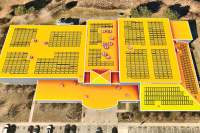Off course: Strange species make 'accidental' appearances in the Smokies
 Normally found only in the western U.S., an accidental rufous hummingbird was seen at Clingmans Dome and added to the park list in 2020. Jeff Bartlett photo
Normally found only in the western U.S., an accidental rufous hummingbird was seen at Clingmans Dome and added to the park list in 2020. Jeff Bartlett photo
Red-necked phalarope, Bonaparte’s gull, band-rumped storm-petrel and harlequin duck. If you are thinking these don’t sound like names that should be included in a story about the Great Smoky Mountains National Park, you’re right.
These birds aren’t usually in the park. But they have been documented as “accidentals” — species that show up outside their normal range, often making a one-time-only appearance.
“In published bird lists generally, species which have been entered upon the basis of one occurrence only, are called ‘accidentals,’” wrote the field biologist and zoologist Joseph Grinnell in his 1922 paper “The Role of the Accidental.”
The most recent example in the Smokies is a limpkin that hung around Cades Cove much of this past fall. Florida is typically the northern edge of this tropical wetland bird’s range. There are two conflicting theories that possibly explain its presence in the open fields, grasses and water bodies of the cove.

Limpkins are large wading birds known for their shrieking cries. Court Harding photo
“Either the limpkins blew in on the coattails of a hurricane — like the flamingo sightings last fall from Alabama, Pennsylvania, North Carolina and other states,” said Smokies Science Coordinator Paul E. Super, “or this is part of a larger expansion of their range, as individuals have been seen outside of their usual U.S. range (Florida and southern Georgia) more frequently in recent years, possibly linked to expansion of invasive apple snails, a food item of choice.”
Related Items
The apple snail was found in North Carolina for the first time in October, when the N.C. Wildlife Resources Commission confirmed its presence along the Lumber River in Lumberton. It has not yet been found in Tennessee.
While ornithologists puzzle over which theory to credit, in addition to the Cades Cove bird, there were at least two limpkins documented in Western North Carolina last fall, several in the Maryville, Tennessee, area, and probably another in Knoxville.
Such accidental sightings are not limited to limpkins. Back in May 2001, Keith Watson of the Southern Appalachian Bird Conservancy remembers walking up to Purchase Knob from the entrance road with his wife, Ruth, and one of his then U.S. Fish and Wildlife Service colleagues, Chuck Hunter.
“When we exited the forest and entered into the grassy section of the Knob, Chuck exclaimed, ‘Chestnut-collared longspur!’ Not having seen one or heard one before, the chase was on,” Keith recalled. “We both ran up the hill, found the bird, confirmed the identification and made some notes on field marks so we could adequately document the observation and record.”
A few of the other vagrant birds (some also use the term “vagrant” to describe these species) that have been added to the park list over the years include a sooty tern in 1926, white-winged crossbills in both 1963 and 1981, a swallow-tailed kite in 2010, a rufous hummingbird in 2020 and a Townsend’s solitaire in 2021.
How do accidentals happen? Storms can blow individuals in from the coast, or low, icy clouds force traveling shorebirds down onto the park during migration. It’s also possible for individual birds of western species to make a 90 (or 270) degree shift in their migratory orientation and begin traveling east rather than south.
Fred Alsop, author of “Birds of the Smokies,” (rereleased in a new edition by Great Smoky Mountains Association in 2023), was guiding a birding tour in Cades Cove on a spring morning in 1989. He led the birders onto Sparks Lane to check the open fields.
“Just after fording Abrams Creek,” Alsop said, “we were walking south along the gravel roadway when I spotted a gray bird with a long tail perched on one of the barbed-wire fences across the field towards the wastewater settling ponds. I quicky identified it as a scissor-tailed flycatcher, much to my delight and the excitement of the group.”

Fred Alsop, author of ‘Birds of the Smokies,’ found scissor-tailed flycatcher, normally a more southerly species, in Cades Cove while leading a birding tour. Nathan Vaughn photo
These wastewater settling ponds constitute the only big bodies of still water in Cades Cove, and as such can attract bird species not commonly found in other parts of the park. On a late fall day not long after the flycatcher sighting, Alsop glimpsed a small grayish shorebird swimming on the surface of the nearest pond.
“As I watched, it would often spin slowly like at top in tight circles and pick at the materials brought to the surface in this bird-created whirlpool,” he said. “I identified it as a red phalarope, an Arctic Circle-nesting species that generally spends the winter at sea.”
Another cause for accidentals is that, during the normal post-breeding dispersal, young, inexperienced birds may follow a food source or a change in climate to get away from the crowd and explore new territory — and find themselves in an unfamiliar place.
“Birds tend to be the main species for accidental status,” says Super, “partly because they fly and partly because we know enough about their distribution that we can recognize when something is outside its expected range.”
On Sept. 22, 2018, retired park ranger and volunteer Warren Bielenberg was performing a routine butterfly survey in Cades Cove when he noticed something unusual.
“I saw a very large skipper and managed to get identifiable photos of the first park record of a Brazilian skipper,” Bielenberg said. “These are usually found in southern Texas and along the Gulf Coast. The host plants are canna lilies, and I don’t know of any in Cades Cove.”
Even back in 1922, Grinnell could also “conceive of a snail in the role of an ‘accidental,’ an individual which has wandered a few feet or a few rods beyond the usual confines of the habitat of its species. Given the element of time the same processes will hold for the slower moving creatures as they seem to do for those gifted with extreme mobility.”
Super suggested that maybe some animals have been inadvertently assisted by the vehicle of a park visitor — an occurrence more common in coastal areas where birds might take a ride on a large freighter, or reptiles, amphibians or insects might be moved by cars.
“We have a couple observations of armadillos climbing out of pick-ups that were driving down the road in Western North Carolina, possibly explaining how they got to the park,” he said.

The nine-banded armadillo has begun showing up in Great Smoky Mountains National Park in recent years, possibly after hitching a ride with humans in vehicles. Leo Lagos photo
If you are getting the feeling that the term “accidental” doesn’t quite fit, kudos to you. Grinnell in his 1922 paper pointed out that “the way in which the word is used by ornithologists is really a misapplication of the term … The occurrence of individual birds a greater or less distance beyond the bounds of the plentiful existence of the species to which they belong is the regular thing, to be expected. There is nothing really ‘accidental’ about it; the process is part of the ordinary evolutionary program.”
New technologies like the apps eBird and iNaturalist have helped increase our awareness of unusual sightings. Anyone can contribute to documenting accidental sightings in the Smokies by capturing images or sound recordings and uploading them via the iNaturalist app. These submissions provide valuable data for biologists and may include species never before documented in the national park.
As Bielenberg said, “the lesson is that birds and butterflies don’t read or follow field guides, so keep your eyes open, and you may find an unusual critter in the park.”
(Frances Figart (rhymes with “tiger”) is the editor of “Smokies Life Journal” and the Creative Services Director for the 29,000-member Great Smoky Mountains Association, an educational nonprofit partner of Great Smoky Mountains National Park. GSMA provided this piece as part of its “Word from the Smokies” series of columns. Reach Figart at This email address is being protected from spambots. You need JavaScript enabled to view it..)









